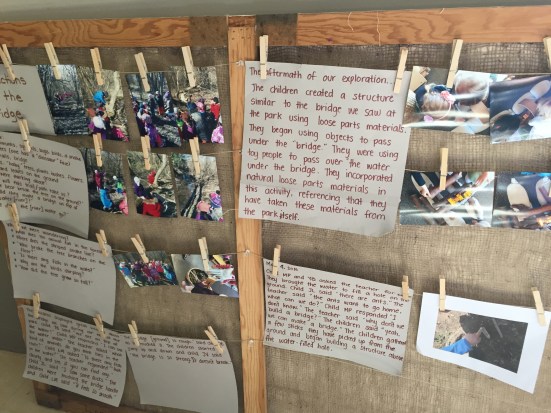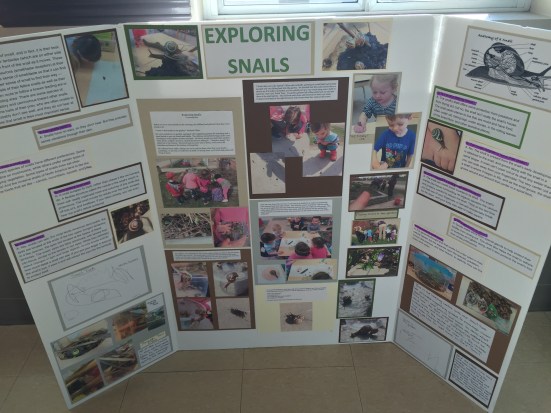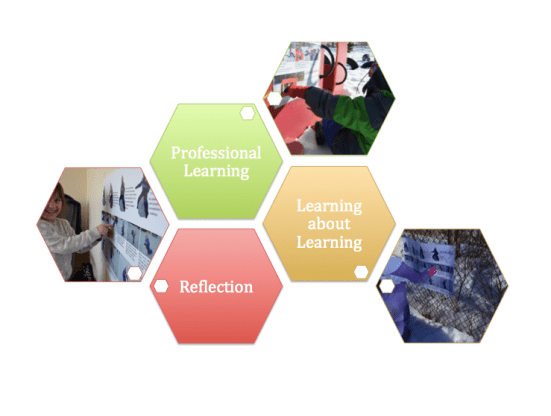By: Diane Kashin, Ed.D, RECE. Ontario’s pedagogy for the early years: How Does Learning Happen (2014) is considered a pedagogical document. It suggests a number of pedagogical approaches to “nurture learning and development in the early years” that includes “using pedagogical documentation as a means to value, discuss and make learning visible” (p. 16). In my role as an educator of educators, I am often asked to do workshops about pedagogical documentation and I include opportunities to document to consider the design of the documentation and to have a concrete example from which to look for meaning. It is not pedagogical documentation. It is documentation, yet we are practicing the process of pedagogical documentation. No wonder, educators that I meet are confused. I am confused! It is not an easy process to understand. I have been working on understanding pedagogical documentation for close to two decades.

There are many facets to pedagogical documentation. It defies a simple definition that articulates the depth and breadth of what is meant by pedagogical documentation. It is complex and not easily understood. I feel like I have been in a continued search for meaning. At first I understood documentation as the recording of children’s learning that was displayed. Then I realized that documentation could be pedagogical if it influences the curriculum path. Yet, not all documentation is pedagogical. Is it still worthy? Yes, educators should just keep documenting and collecting data that can be analyzed and interpreted. Not all documentation will end up being pedagogical. Sometimes, the process stops at the collection and the display of documentation. Without interpretation and analysis, it is not pedagogical. It still is data collected from the practice of teaching and learning, and that’s okay.
If pedagogy is the study of teaching and learning, and documentation serves as a record, then pedagogical documentation is the recording of the teaching and learning in a way that influences future teaching and learning. It is not a straightforward listing of daily events, but rather a study of those events as they relate to teaching and learning. During visits to programs, I see documentation posted and displayed on the walls, yet the content is only a recording of a past event and mostly just photos. This is not pedagogical but it is an attempt to make learning visible. My colleague Cindy Green refers to this level of documentation as “scrapbooking”. Avoiding scrapbooking and finding depth is not easy. It will take time. Cindy would tell you to keep documenting! You also need to be beware of having too much text as this helpful guideline to creating documentation: The Anatomy of a Documentation Panel suggests.

To attain the right balance of text to photos takes practice.To attain the depth associated with pedagogical documentation, the idea is to interact with the collections of notes, video recordings, photos, children’s drawings and to encourage others to interact. The others would be educators, administrators, children and families. Documentation should make children’s learning experiences visible but it also needs to extend the learning process of both children and their teachers. According to Rinaldi (2006):
Documentation, therefore, is seen as visible listening, as the construction of traces (through notes, slides, videos, and so on) that not only testify to the children’s learning path and processes, but also make them possible because they are visible. For us this means making visible, and this possible, the relationships that are the building blocks of knowledge. (p. 68)
When documentation is embedded into practice, pedagogy and curriculum decisions can be based on the real meaningful experiences of children. To be pedagogical it has to involve interpretation. I would suggest that it is impossible to analyze every photo and every drawing of every child. This becomes more problematic when too much emphasis is placed on the recording of the obvious – for example, “we went to the park today” rather than trying to see the deeper meaning.

Collecting a critical mass of observations and photos through digital means and then sharing them via email, social media or a software app is documenting. Sharing the same by printing them out and posting on panels or bulletin boards is documenting. However, by sharing, there is ample opportunity for that documentation to become pedagogical but it takes time . I recently had an experience of viewing documentation that included a variety of photos of children interacting with loose parts and the recording of their responses to the materials. They had a number of different reactions to the experience including pretending they had made a birthday cake. I was asked whether the next steps would be to make cake with the children. There is nothing wrong with cake! However, for the documentation to be become pedagogical it needs further reflection for deeper meaning. Rather than decide so quickly what the next steps will be, I recommended that further documentation should be collected.

Pedagogical documentation can be viewed as a “process to explore all of our questions about children” (Ministry of Education, 2014, p. 21). Documentation becomes pedagogical when it is interpreted and analyzed by the educators and children who create the content and those that view it. Making the documentation accessible to others (children, families, other educators, community members) and inviting interpretations of what is seen provides multiple perspectives that forms foundational information that contributes to the creation of a curriculum path that is authentic to those involved. In the meantime, the documentation will support professional learning and reflection and will be an effective way to learn about learning. Not all documentation is pedagogical and that is okay. Keep documenting; sharing and looking for deeper meaning. Getting to the level of pedagogical documentation is a process that takes time and intention. It takes practice. Accept that all your attempts may not be pedagogical but as you document you will be learning about the learning processes of children and engaging in professional development and reflection.
On weekly program plans, would you consider an experience or acivity to be the interpretive result of the noted observation (added on the plan to support the child-initiated experience or activity)? Or do you think that in the child’s observation book, the observation used in planning should be interpreteted, and the interpretation (along with the obervation?) be what is written on the plan for support?
LikeLike
I think all documentation can be analyzed and in terms of projecting the curriculum, documentation that depicts group experiences may help you to consider curriculum directions that support more than one child.
LikeLike
In the individualized context, though, and to indicate pedagogical documentation to support an experience, I was wondering if more than the observation itself should be indicated on the program plan. I was thinking, after reading your blog today, that showing the interpretation leading to the experience included in the program plan (curriculum) would better reflect documentation in the intended manner of the ELECT, which is important to the overall program as well as the AQI.
LikeLike
I think you are on to something. Without knowing the program plan format that you use it is hard for me to say for sure. However, I think showing interpretation will support the in depth meaning we are all searching for 🙂
LikeLike
Thanks for speaking with me about this.
LikeLiked by 1 person
How much fun was that??? As I was just leaving the house to present on pedagogical documentation, this blog post arrived. Together with 18 educators, we engaged in the process of creating documentation, guided by the What? So What? Now What? framework. We played, documented and interpreted our own learning about engaging in the experience. we had 4 hours and we were able to agree on some next steps for our own learning. This experience hopefully will position educators to engage in a similar process as they create deeper and more meaningful pedagogical documentation. Yes, the process took TIME and the panels and portfolio entries will become richer as educators reflect on and revisit their work.
When I grow up Diane, I am going to be a thinker and a writer just like you! lol
LikeLike
You are a thinker Cindy! You are a very deep thinker and a kind, generous person. You also write well and edit really well. So you better come up with something else to be when you grow up 🙂 🙂
LikeLike
The process of documentation is one of critical reflection in order to make meaning. Through deeper questioning and the sharing of observations, multiple perspectives come to bear on the process of meaning making. It is in these rich moments of being that we analyze ‘the work’ if you will to create a sense of who we are this time and in this place.
LikeLiked by 1 person
Thank you Diane for helping keep this conversation alive. I feel like there are times the term “pedagogical documentation” carries so much weight, educators feel it’s a burden upon them as opposed to a useful tool. It is part of daily practice, constantly evolving our practice, if we look with curious eyes.
I think of it a bit like the pictures in our camera role (or device or what have you) – the act of taking pictures itself is collecting data, certainly, but not leading to any new learning if left at that. However, once we begin interacting with our photos, deleting those that don’t help us, looking and trying to find a thread over several days of play, we do see patterns and questions emerge… what is this group trying to do? Why do they go back again and again? Or: where else have I seen this game pop up in our class? I love the way children interact with the sets we create, too – often changing the sorting, rejecting my categories, showing new ones, or adding back-story to games I didn’t capture during the play.
In reviewing, deleting, sorting through our photos and notes to find these threads, we begin to stir up memories and theories based on our experiences with children (not just those currently in our care). Our practice, our pedagogy, it can’t help but be impacted by what we notice. Our very classrooms change as we move, remove or add items upon reflecting on their use. Some years, my classroom is full of small objects, mirrors, jars filled or empty for child use, and marbles. This year, after seeing these objects as problematic and unsafe for several students, they were removed (to higher shelves, for use with educators closely) while other materials were added to support more self-regulated play in our current context. Our practice, our space, reflects the ongoing discussions between my partner and I about how to best support our learners. It’s never “done” and in that way ped. doc. is like learning itself – a lifelong process of change and growth.
LikeLiked by 1 person
Thank you Diane . It is so important to think and discuss the topic of documentation. It continues to reinforce the need for intention, practice and conversation among colleagues. Being a reflective practitioner requires us to be patient with ourselves and to sometimes leave space to just practice……
LikeLiked by 1 person
This is a topic I have thought about a lot. Really, it is a huge challenge to go through the entire pedagogical narration and truly get meaningful input and participation from parents and children. I have given myself permission to do whatever steps I can in the process and know that sometimes it will move further along than others. Whenever I get a chance to reflect with parents, children, or co-workers on learning through play I come to new realizations so I completely see the value of being reflective. It is just so nice to feel content knowing that not every experience can be fully reflected upon to the extent that we like because, let’s face it, with young children there is action happening all the time. To capture and reflect on every moment would be impossible and exhausting.
LikeLiked by 1 person
Pingback: What about the What? Finding the Deeper Meaning in Pedagogical Documentation | Technology Rich Inquiry Based Research
This documentation of child or children is important factor in their growing up , I feel that the time that it takes to do this and are special moments in a child’s life . I believe these should be passed on in the parents hands once they leave daycare .
LikeLike
Pingback: Changing Perspectives: Viewing Documentation from a Different Lens | Storypark Blog
Pingback: 23 Organized Ways to Document the Preschool Years - Teaching Expertise
I know that this post date from 2016, but it does have so much meaningful information. Thank you!
LikeLiked by 1 person